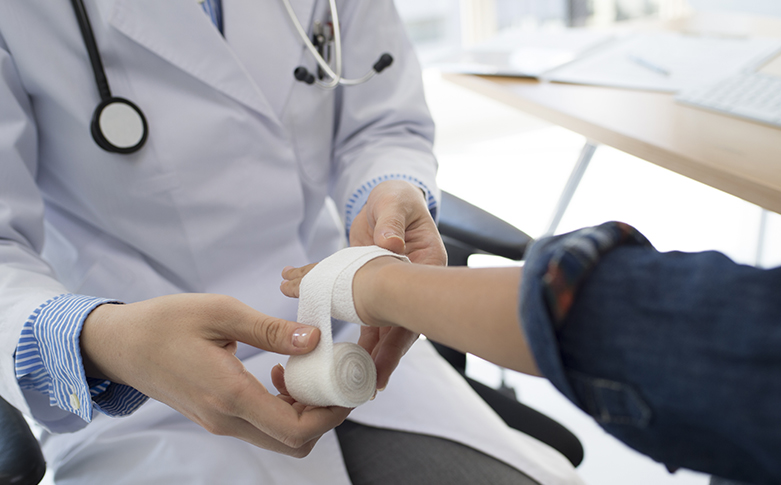
Image: Blend Images Photography | Veer
As a healthcare provider, you know that a patient’s body language often tells you more than her words do about how she’s feeling. At the same time, you’re sending your patients messages with your own body language. Rarely do we think about what message our body language might be sending. If your body language is relaxed and confident, you can help patients feel more relaxed and confident.
Many of your gestures, or nonverbals, are called baseline behaviors. You do them every day. You’ve been doing them for years. They’re automatic and may or may not be sending the message you want.
Five Body Gestures to Avoid
The following common five gestures do not display self-confidence; in fact, they actually lower your image in the eyes of the patient and fellow healthcare providers.
1. Fig-leaf hands. When you stand with one hand on top of the other, covering the groin region, you look smaller. Your body is saying, “I’m harmless,” “I’m shy” or “I’m afraid.” No matter how confident you feel or how much you know, the fig-leaf pose says, “I’m trying to be small.”
It’s like calling someone on the phone and then saying, “Oh, it’s just me.” No! It’s not just you! It’s You. The confident You. Get rid of that fig-leaf gesture (and the “fig-leaf” words “just me”).
2. Hands or thumbs in pockets. Hanging your thumbs off of your pockets, or having your hands deep in your pockets, usually sends a message of diminished self-confidence, something like “Geez, I hope you like me.” Worse yet, hands in pockets jiggling change is as good as saying, “I’m nervous and I hope you like me.” It can also send a message of exaggerated self-importance such as “I know I’m pretty neat” or “Let’s get moving here, I’m really bored.”
Pockets and waistbands are fraught with meaning. Tucking your thumbs into your waistband usually says, “I’m staking my territory,” which is a gesture of power, not influence. Avoid pockets and waistbands.
3. Hands clasped behind your back. Depending on context, this gesture, similar to the fig-leaf, can make you look smaller, as if to say, “I hope you like me.”
However, if someone has his hands clasped behind his back as part of a bigger pattern, often referred to as “the royal strut” (erect posture, slow gait, head held high), the body is saying, “You’d better fear me.” The royal strut conveys superiority and extreme self-confidence, and sends the message “I know I have power.”
4. Arms crossed over your chest. This stance is probably the most misinterpreted gesture. To some people it says, “I’m annoyed.” Others think it says, “I’m not open to discussion. I stand firm on what I said.”
But here’s another way to look at it. Some people automatically cross their arms when they are listening. Some cross their arms when they are cold. Maybe they are simply trying to hide a spot on their shirt or uniform. This gesture may be comfortable and easy, but it’s difficult to overcome what others read into this gesture. Try your best to avoid it simply because it’s loaded with so many misunderstandings and meanings of discomfort or being closed off.
5. Hands on hips. While this gesture makes you look bigger‚ it definitely carries a connotation of annoyance and judgment. It often sends the message “I’m ready for a fight” or “I’m really annoyed with you or the situation.”
Three Good Body Gestures
So what are the types of body language that project “all the right moves” of self-confidence and the expectation of mutual respect? The following three forearm positions that send the message “I am confident, we all know what we’re doing, we are capable and I expect good things.”
1. Gentle hand clasp. Hold your forearms waist-high in front of your body, wrists at the same height as the elbows so that the forearms are parallel to the ground. Hands can be gently clasped together or in a downward steeple gesture where fingertips touch (avoid playing with rings or bracelets).
2. Arms straight down by your sides. This one is physically the most natural, yet often the most uncomfortable to do. It may feel like you’re standing at attention, but it won’t look that way unless you lock your knees. So loosen up the stance a bit and try the arms down by your sides.
3. “Weatherperson” stance. This is the combination of one forearm waist-high in front of your body with the wrist at the same height as the elbow, and the other arm down to your side—a pose often used by your TV weatherperson. This is an excellent stance of confidence.
Other nonverbals that display self-confidence:
- Good posture and relaxed, natural (low) breathing. Comfortable, natural breathing is a key nonverbal that shows you’re confident with who you are. Breathe slowly and deeply.
- Stand tall with erect posture and avoid slouching. Not only do you look defeated when slouching, but you can’t breathe well.
- Move with assurance.
- Watch for any fidgets or nervous gestures, such as twirling rings or playing with your clothes.
When it comes to inspiring and influencing patients and coworkers, it’s important to say the right words, and just as important to use nonverbal cues that correctly align with your best intentions.
Sharon Sayler, MBA, is a Communications Success Strategist who trains professionals on how to become stronger, more influential communicators and leaders. Her latest book, What Your Body Says (And How to Master the Message), is available wherever books are sold, including amazon.com, barnesandnoble.com and whatyourbodysays.com.

















